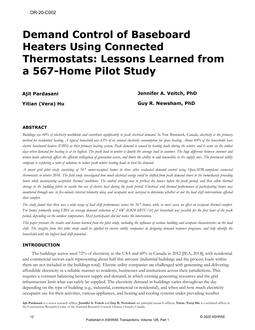Description
Buildings use 60% of electricity worldwide and contribute significantly to peak electrical demand. In New Brunswick, Canada, electricity is the primary method for residential heating. A typical household uses 63% of its annual electricity consumption for space heating. About 48% of the households have electric baseboard heaters (EBH) as their primary heating system. Peak demand is caused by heating loads during the winter, and is acute on the coldest days when demand for heating is at its highest. The peak load in winter is double the average load in summer. The huge difference between summer and winter loads adversely affects the efficient utilization of generation assets, and limits the ability to add renewables to the supply mix. The provincial utility company is exploring a suite of solutions to reduce peak winter heating loads to level the demand.
A smart grid pilot study consisting of 567 owner-occupied homes in three cities evaluated demand control using OpenADR-compliant connected thermostats in winter 2016. The field study investigated how much electrical energy could be shifted from peak demand hours to the immediately preceding hours while maintaining acceptable thermal conditions. The control strategy was to preheat the houses before the peak period, and then allow thermal storage in the building fabric to enable low use of electric heat during the peak period. Electrical and thermal performance of participating homes was monitored through one- to five-minute interval telemetry data, and occupants were surveyed to determine whether or not the load shift interventions affected their comfort.
The study found that there was a wide range of load shift performance across the 567 homes, with, in most cases, no effect on occupant thermal comfort. For homes primarily using EBH an average demand reduction of 2 kW (6.824 kBTU/hr) per household was possible for the first hour of the peak period, depending on the outdoor temperature. Most participants did not notice the intervention.
This paper presents the results and lessons learned from the pilot study, including the influence of various building and occupant characteristics on the load shift. The insights from this pilot study could be applied by electric utility companies in designing demand response programs, and help identify the households with the highest load shift potential.
Citation: 2020 Winter Conference, Orlando, FL Conference Papers
Product Details
- Published:
- 2020
- Number of Pages:
- 9
- Units of Measure:
- Dual
- File Size:
- 1 file , 1000 KB
- Product Code(s):
- D-OR-20-C002




